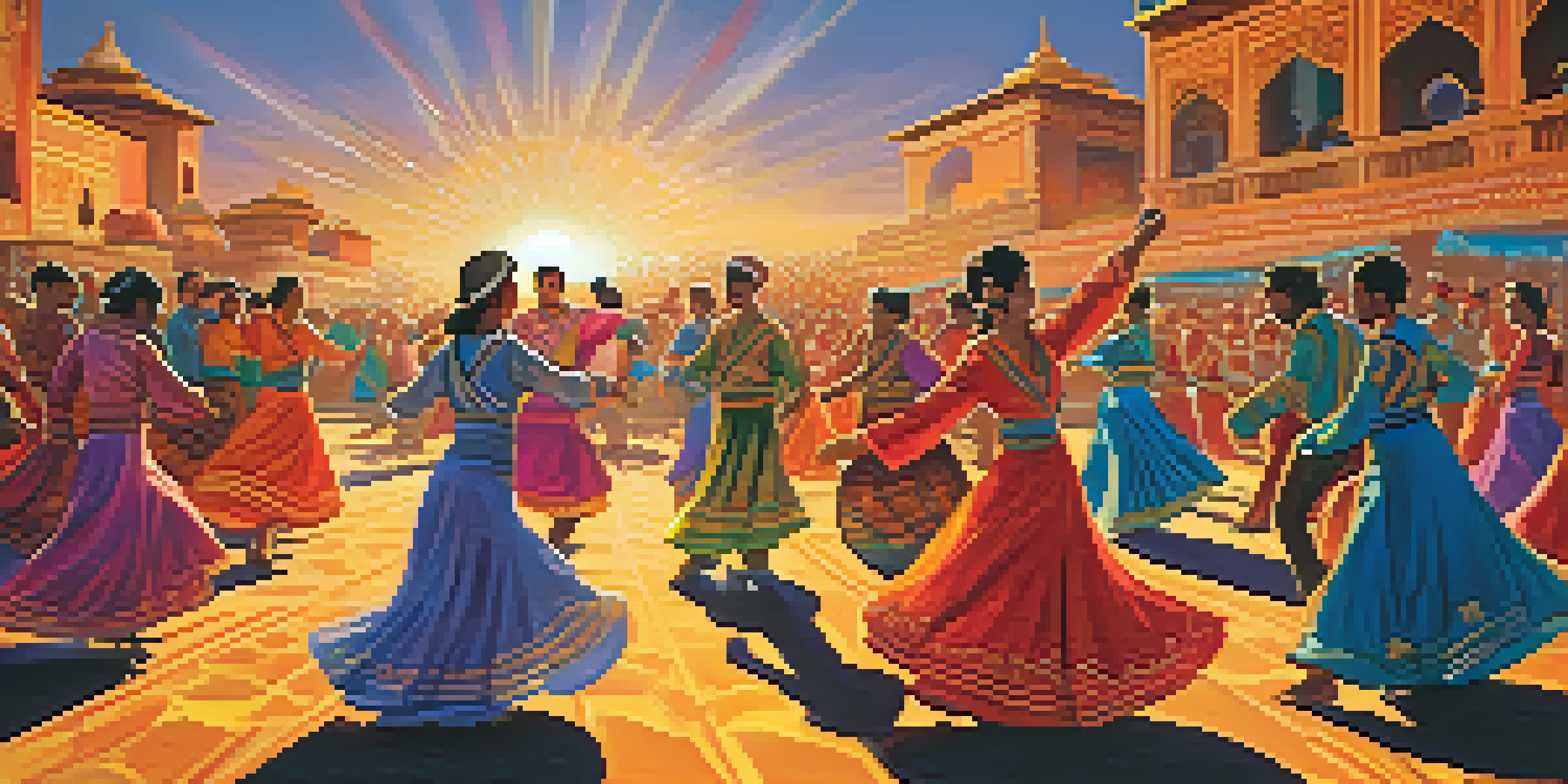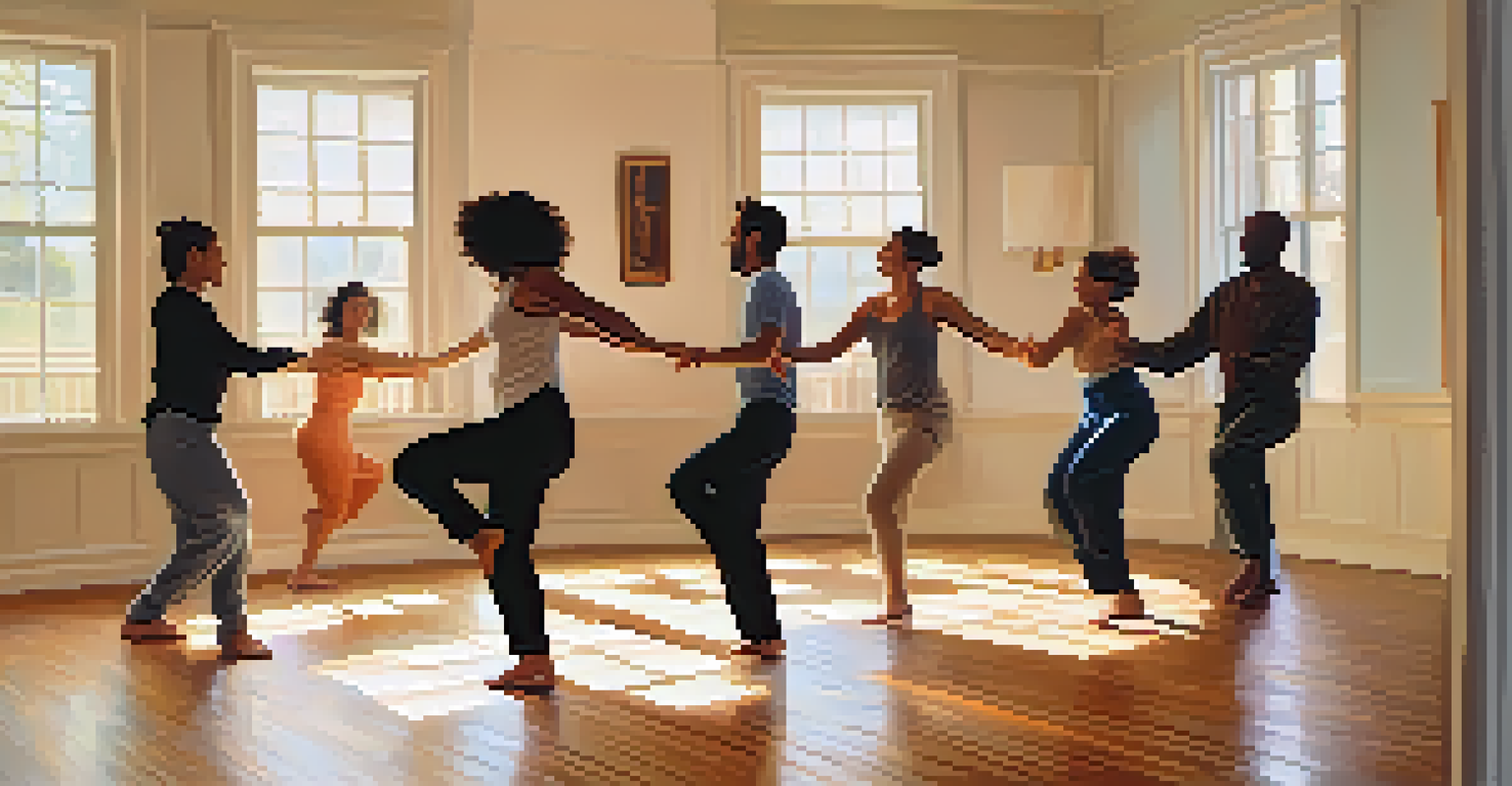The Role of Dance in Expressing Emotions and Feelings

Understanding Dance as a Form of Emotional Expression
Dance is not just about movement; it’s a powerful language of emotions. Through rhythm and body movements, dancers convey feelings that words often cannot express. Whether it's the joy of a celebratory dance or the sorrow of a slow waltz, each gesture tells a story.
Dance is the hidden language of the soul.
Historically, cultures around the world have used dance to communicate feelings, celebrate events, and even heal. Take, for example, traditional folk dances that reflect community joy or mourning. These movements create a shared experience, connecting dancers and audiences alike.
In contemporary settings, dance continues to be a vital outlet for emotional expression. Modern dance styles, from hip-hop to contemporary, allow for personal storytelling, where individual experiences can resonate with others, fostering empathy and understanding.
The Psychological Benefits of Dance in Expressing Emotions
Engaging in dance can have profound psychological benefits, acting as a therapeutic release for pent-up emotions. When people dance, they often find a safe space to explore feelings like anger, sadness, or joy. This release can lead to improved mental well-being.

Research has shown that movement can trigger the release of endorphins, the body’s natural mood lifters. This means a simple dance session can transform a bad day into one filled with positivity and light. It’s fascinating how moving our bodies can shift our emotional landscapes.
Dance as Emotional Expression
Dance serves as a powerful medium for conveying emotions that words often cannot express.
Moreover, dance fosters mindfulness. When we focus on the rhythm and our movements, we can be present in the moment, allowing us to process our emotions more effectively. This practice can be incredibly restorative, leading to a deeper understanding of ourselves.
Dance as a Universal Language of Emotion
One of the most remarkable aspects of dance is its ability to transcend language barriers. No matter where you come from, the movements can evoke similar feelings and reactions. A joyful dance in Brazil can spark happiness in someone from Japan, highlighting dance’s universal appeal.
Dancing is creating a sculpture that is visible only for a moment.
This universality enables a shared emotional experience, often bringing people together across cultures. For instance, dance festivals around the world celebrate diversity while showcasing how similar emotions can be expressed in unique ways.
Moreover, this shared language fosters community and connection. When people from different backgrounds come together to dance, it creates a sense of belonging and mutual understanding, allowing for emotional bonds that might not form through words alone.
Using Dance to Process Grief and Loss
Dance can also serve as a powerful tool for processing grief and loss. Many choreographers create pieces that reflect their personal experiences with loss, allowing audiences to witness and empathize with their journey. It’s a poignant reminder that we are not alone in our feelings.
For example, some dance therapy programs encourage participants to express their grief through movement. This can be incredibly cathartic, helping individuals to release emotions they may struggle to articulate. The act of dancing becomes a healing practice, transforming pain into art.
Psychological Benefits of Dance
Engaging in dance promotes mental well-being by providing a therapeutic release for pent-up emotions.
Additionally, memorial dances or performances honoring loved ones can provide closure. They allow dancers to celebrate the life of someone who has passed, turning sorrow into a tribute filled with love and remembrance.
The Role of Dance in Celebrating Joyful Moments
On the flip side of the emotional spectrum, dance is often synonymous with celebration and joy. From weddings to festivals, dance serves as a physical manifestation of happiness, bringing people together to share in joyful moments. It’s that infectious energy that can light up a room.
Consider the traditional group dances at celebrations; they not only reflect individual joy but also enhance collective happiness. When we see others moving joyfully, it encourages us to join in, creating a vibrant atmosphere filled with shared excitement.
Moreover, the act of dancing can elevate our mood, making it a go-to activity during celebrations. Whether it’s a spontaneous dance party or a carefully choreographed performance, the joy of dance encourages connection and creates lasting memories.
Dance as a Medium for Social Commentary
Beyond personal expression, dance can also serve as a powerful medium for social commentary. Many choreographers use their art to reflect societal issues, telling stories that resonate deeply with audiences. This form of expression can raise awareness and provoke thought.
For instance, dance pieces addressing topics like inequality or injustice can evoke strong emotional responses. By highlighting these issues through movement, artists invite viewers to feel and reflect, fostering a deeper understanding of the world around them.
Dance Unites Across Cultures
Dance transcends language barriers, creating shared emotional experiences that foster community and connection.
This aspect of dance highlights its role as a vehicle for change. When feelings are expressed through movement, they can resonate on a broader scale, inspiring conversations and encouraging audiences to take action.
The Future of Dance in Emotional Expression
As we look to the future, the role of dance in expressing emotions is likely to evolve alongside technology and societal changes. With the rise of digital platforms, more people are discovering dance as a means of self-expression, often sharing their journeys online. This trend fosters a sense of community and connection.
Innovations in technology, such as virtual reality, are also changing how we experience and participate in dance. Imagine immersing yourself in a virtual dance class or watching performances from around the world. These experiences can deepen our emotional connections to dance.

Ultimately, the future of dance will continue to reflect our collective emotions, adapting to new forms of expression while remaining a timeless medium for connection and understanding.